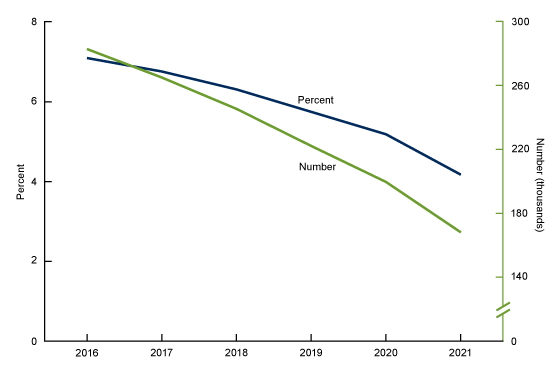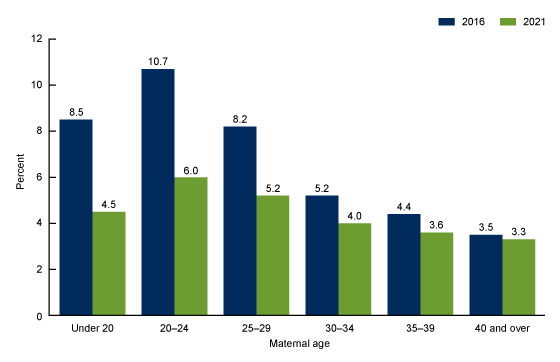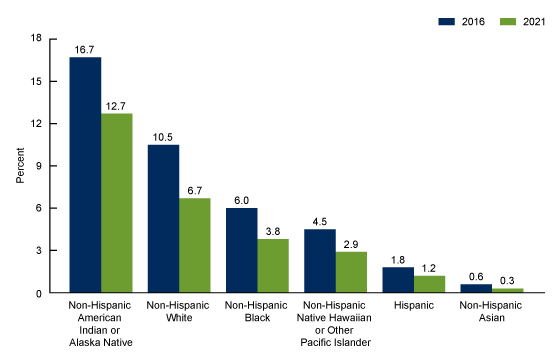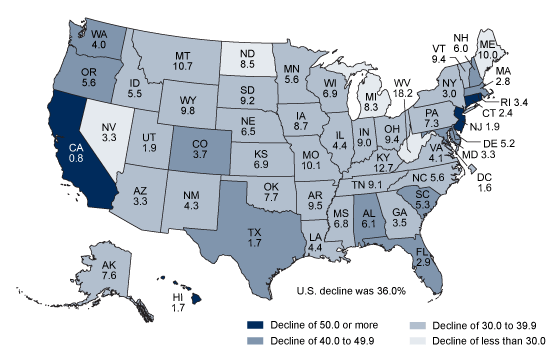Declines in Cigarette Smoking During Pregnancy in the United States, 2016–2021
NCHS Data Brief No. 458, January 2023
PDF Version (511 KB) | Visual Abstract
Joyce A. Martin, M.P.H., Michelle J.K. Osterman, M.H.S., and Anne K. Driscoll, Ph.D.
- Key findings
- Smoking during pregnancy declined by approximately one-third in the United States from 2016 to 2021.
- Cigarette smoking during pregnancy declined for each maternal age group from 2016 to 2021.
- Cigarette smoking during pregnancy declined for each of the race and Hispanic-origin groups from 2016 to 2021.
- Cigarette smoking during pregnancy declined in all 50 states and the District of Columbia between 2016 to 2021.
- Summary
Data from the National Vital Statistics System
- From 2016 to 2021, the percentage of mothers who smoked cigarettes during pregnancy declined by more than one-third, from 7.2% to 4.6%.
- The percentage of mothers who smoked during pregnancy declined across all maternal age groups between 2016 and 2021; declines ranged from 6% to 47%.
- The percentage of mothers who smoked during pregnancy declined across all race and Hispanic-origin groups between 2016 and 2021; declines ranged from 24% to 50%.
- Smoking during pregnancy declined in all 50 states and the District of Columbia between 2016 and 2021.
Smoking during pregnancy is an established risk factor for adverse pregnancy outcomes and health issues for newborns later in life (1–3). National birth certificate data on cigarette smoking and the number of cigarettes smoked before and during pregnancy first became available in 2016. These data allow for the analysis of maternal cigarette use during pregnancy by numerous maternal and infant characteristics. This report describes changes in the number and percentage of mothers who smoked cigarettes at any time during pregnancy in the United States from 2016 to 2021 and changes between 2016 and 2021 in the percentage of mothers who smoked during pregnancy by maternal age, race and Hispanic origin, and state of residence.
Keywords: maternal age, race and Hispanic origin, state of residence, National Vital Statistics System
Smoking during pregnancy declined by approximately one-third in the United States from 2016 to 2021.
- The percentage of mothers who smoked cigarettes at any time during pregnancy declined by 36% from 2016 to 2021, from 7.2% to 4.6% (Figure 1).
- The percentage of mothers who smoked during pregnancy declined by an average of 8% annually from 2016 to 2021, with the largest decline occurring from 2020 to 2021 (16%).
- The number of mothers who smoked during pregnancy declined by 41% between 2016 (282,712) and 2021 (168,086).
- The number of mothers who smoked during pregnancy declined by an average of 10% annually from 2016 to 2021, with the largest decline occurring from 2020 to 2021 (16%).
Figure 1. Number and percentage of mothers who smoked cigarettes during pregnancy: United States, 2016–2021

NOTES: Significant declining trends in numbers and rates from 2016 to 2021 (p < 0.05). Access data table for Figure 1.
SOURCE: National Center for Health Statistics, National Vital Statistics System, Natality.
Cigarette smoking during pregnancy declined for each maternal age group from 2016 to 2021.
- The percentage of mothers who smoked during pregnancy declined across all maternal age groups between 2016 and 2021. The declines ranged from 6% to 47% (Figure 2).
- The largest declines were for mothers under age 30: 47% for mothers aged under 20 (from 8.5% to 4.5%), 44% for mothers aged 20–24 (10.7% to 6.0%), and 37% for mothers aged 25–29 (8.2% to 5.2%).
- The percentage smoking during pregnancy declined by 23% for mothers aged 30–34 (5.2% to 4.0%), by 18% for mothers aged 35–39 (4.4% to 3.6%), and by 6% for mothers aged 40 and over (3.5% to 3.3%).
- Despite the larger declines in smoking levels among mothers under age 30, these mothers continued to be more likely to smoke than mothers aged 30 and over in 2021.
Figure 2. Percentage of mothers who smoked cigarettes during pregnancy, by maternal age: United States, 2016 and 2021

NOTES: Significant declines for all age groups between 2016 and 2021 (p < 0.05). Significant decreasing trend by age from mothers aged 20–24 to mothers aged 40 and over (p < 0.05) for 2016 and 2021. Access data table for Figure 2.
SOURCE: National Center for Health Statistics, National Vital Statistics System, Natality.
Cigarette smoking during pregnancy declined for each of the race and Hispanic-origin groups from 2016 to 2021.
- The percentage of mothers who smoked during pregnancy declined across all race and Hispanic-origin groups between 2016 and 2021. The declines ranged from 24% to 50% (Figure 3).
- Although the rates of smoking during pregnancy were very small for non-Hispanic Asian mothers, they experienced the largest decline (50%, from 0.6% to 0.3%), followed by non-Hispanic Black (37%, from 6.0% to 3.8%) and non-Hispanic White (36%, from 10.5% to 6.7%) mothers.
- Percentages also declined for non-Hispanic Native Hawaiian and Other Pacific Islander (36%, from 4.5% to 2.9%), Hispanic (33%, from 1.8% to 1.2%), and non-Hispanic American Indian or Alaska Native (24%, from 16.7% to 12.7%) mothers.
- In 2016 and 2021, levels of smoking during pregnancy were lowest among non-Hispanic Asian and Hispanic mothers and highest among non-Hispanic American Indian or Alaska Native and non-Hispanic White mothers.
Figure 3. Percentage of mothers who smoked cigarettes during pregnancy, by race and Hispanic origin: United States, 2016 and 2021

NOTES: Declines for all race and Hispanic-origin groups between 2016 and 2021 and differences between race and Hispanic-origin groups between 2016 and 2021 were significant (p < 0.05). Access data table for Figure 3.
SOURCE: National Center for Health Statistics, National Vital Statistics System, Natality.
Cigarette smoking during pregnancy declined in all 50 states and the District of Columbia between 2016 to 2021.
- The percentage of mothers who smoked during pregnancy declined in all 50 states and the District of Columbia between 2016 and 2021. The declines ranged from 18% to 54% (Figure 4).
- The largest declines were seen in Rhode Island (54%), Hawaii (53%), Connecticut (51%), New Jersey (51%), and California (50%), although most of these states also had some of the lowest rates of smoking during pregnancy.
- Declines in maternal cigarette smoking of 40% to 48% were reported for 11 states, and of 30% to 39% for 29 states and the District of Columbia. Four states declined by 27% to 29% (Maine, Michigan, North Dakota, and West Virginia) and one state by 18% (Nevada).
- In 2021, levels of smoking during pregnancy ranged from a low of 0.8% in California to a high of 18.2% in West Virginia.
Figure 4. Percentage of mothers who smoked cigarettes during pregnancy by state, 2021, and change in percentage of mothers who smoked during pregnancy: United States and each state, from 2016 to 2021

NOTES: Significant declines for all states between 2016 and 2021 (p < 0.05). Access data table for Figure 4.
SOURCE: National Center for Health Statistics, National Vital Statistics System, Natality.
Summary
Birth certificate data show substantial declines in maternal cigarette smoking during pregnancy among mothers giving birth between 2016 and 2021 overall, across maternal age, race and Hispanic-origin groups, and in all 50 states and the District of Columbia. The percentage of mothers who smoked during pregnancy declined 36% from 2016 to 2021, with the largest single-year decline of 16% occurring from 2020 to 2021. The number of births to mothers who smoked during pregnancy declined by 41% from 2016 to 2021 and included a 16% drop from 2020 to 2021. In contrast, the total number of births in the United States declined 8% from 2016 to 2020 and then rose 1% between 2020 and 2021 (4). Reports on smoking among the adult U.S. population indicate declines in cigarette smoking and in the use of electronic cigarettes in recent years (5).
Although differences in the prevalence of smoking during pregnancy narrowed across age and race and Hispanic-origin groups and among the U.S. states between 2016 and 2021, mothers under age 30, non-Hispanic American Indian or Alaska Native mothers, non-Hispanic White mothers, and mothers in 10 states (Arkansas, Kentucky, Maine, Missouri, Montana, Ohio, South Dakota, Vermont, West Virginia, and Wyoming) continued to have the highest smoking prevalence in both years.
Definitions
Smoking during pregnancy: The number of births to mothers who reported smoking cigarettes at any point during pregnancy per 100 births in the given category and is based on the birth certificate item “Cigarette smoking before and during pregnancy.” This report is based on information on mothers who smoked at any point during, not before, pregnancy.
Data source and methods
This report uses data from the Natality Data File from the National Vital Statistics System. The vital statistics natality file is based on information derived from birth certificates and includes information for all births occurring in the United States (6).
Information on maternal smoking during pregnancy is recommended to be self-reported by the mother around the time of delivery (6). The race and Hispanic-origin groups shown follow the 1997 Office of Management and Budget standards and differ from the bridged-race categories shown in reports before 2016.
The difference between any percentages noted in the text are statistically significant at the 0.05 level unless otherwise noted. References to decreasing linear trends are statistically significant at the 0.05 level and are assessed using the Cochran-Armitage test for trends, a modified chi-squared test.
About the authors
Joyce A. Martin, Michelle J.K. Osterman, and Anne K. Driscoll are with the National Center for Health Statistics, Division of Vital Statistics, Reproductive Statistics Branch.
References
- Avşar TS, McLeod H, Jackson L. Health outcomes of smoking during pregnancy and the postpartum period: An umbrella review. BMC Pregnancy Childbirth 21(1):254. 2021.
- Quelhas D, Kompala C, Wittenbrink B, Han Z, Parker M, Shapiro M, et al. The association between active tobacco use during pregnancy and growth outcomes of children under five years of age: A systematic review and meta-analysis. BMC Public Health 18(1):1372. 2018.
- Dietz PM, England LJ, Shapiro-Mendoza CK, Tong VT, Farr SL, Callaghan WM. Infant morbidity and mortality attributable to prenatal smoking in the U.S. Am J Prev Med 39(1):45–52. 2010.
- Osterman MJK, Hamilton BE, Martin JA, Driscoll AK, Valenzuela CP. Births: Final data for 2021. National Vital Statistics Reports; vol 72 no 1. Hyattsville, MD: National Center for Health Statistics. 2023. DOI: https://dx.doi.org/10.15620/cdc:122047.
- American Lung Association. Overall tobacco trends. 2022.
- National Center for Health Statistics. User guide to the 2020 natality public use file. 2021.
Suggested citation
Martin JA, Osterman MJK, Driscoll AK. Declines in cigarette smoking during pregnancy in the United States, 2016–2021. NCHS Data Brief, no 458. Hyattsville, MD: National Center for Health Statistics. 2023. DOI: https://dx.doi.org/10.15620/cdc:123360.
Copyright information
All material appearing in this report is in the public domain and may be reproduced or copied without permission; citation as to source, however, is appreciated.
National Center for Health Statistics
Brian C. Moyer, Ph.D., Director
Amy M. Branum, Ph.D., Associate Director for Science
Division of Vital Statistics
Steven Schwartz, Ph.D., Director
Andrés A. Berruti, Ph.D., M.A., Associate Director for Science